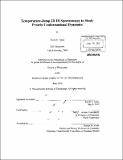| dc.contributor.advisor | Andrei Tokmakoff. | en_US |
| dc.contributor.author | Jones, Kevin C. (Kevin Chapman) | en_US |
| dc.contributor.other | Massachusetts Institute of Technology. Dept. of Chemistry. | en_US |
| dc.date.accessioned | 2012-09-27T15:24:54Z | |
| dc.date.available | 2012-09-27T15:24:54Z | |
| dc.date.issued | 2012 | en_US |
| dc.identifier.uri | http://hdl.handle.net/1721.1/73358 | |
| dc.description | Thesis (Ph. D.)--Massachusetts Institute of Technology, Dept. of Chemistry, 2012. | en_US |
| dc.description | "June 2012." Cataloged from PDF version of thesis. | en_US |
| dc.description | Includes bibliographical references. | en_US |
| dc.description.abstract | Temperature-jump (T-jump) two-dimensional infrared spectroscopy (2D IR) is developed, characterized, and applied to the study of protein folding and association. In solution, protein conformational changes span a wide range of timescale from nanoseconds to minutes. Ultrafast 2D IR spectroscopy measures time-dependent structural changes within the protein ensemble by probing the frequency changes associated with amide I backbone vibrations. Combining 2D IR with a perturbing laser-induced T-jump enables the study of conformational dynamics from 5 ns to 50 ms. To access a finer time-sampling of the conformational evolution, a one-dimensional variant of 2D IR, heterodyne-detected dispersed vibrational echo spectroscopy (HDVE), is implemented. The framework for interpreting transient HDVE and 2D IR spectra is developed, and we propose a method to remove the linear absorption distortions along both frequency axes. We first present the T-jump 2D IR spectra of a dipeptide to reveal the general amide I baseline response expected in the absence of conformational change. To facilitate the analysis of T-jump data, singular value decomposition (SVD) is employed for reducing noise, identifying the number of distinguishable states, and separating spectral changes based on shared timescales. Finally, T-jump 2D IR spectroscopy is applied to study the unfolding of ubiquitin, disordering of the 12-residue p-hairpin peptide trpzip2 (TZ2), and the dissociation of insulin dimers to monomers. Experimental results for ubiquitin highlight the importance of linear absorption corrections for interpretation of the data. In response to the T-jump, 2D IR results indicate p-sheet structure melts in ubiquitin with a small amplitude (~10 gs) and large amplitude (17 ms) response. Isotope-labeling T-jump experiments on TZ2 allow for the proposal of a free energy surface in which transitions from a native and misfolded state proceed through a disordered hub-like state with a 1-2 gs timescale. Multiple timescales are observed in the T-jump induced dissociation of insulin. Based on their spectral features and concentration dependence, the insulin timescales can be assigned to dissociation, disordering, and oligomerization processes. With these applications, we demonstrate the capability of T-jump 2D IR spectroscopy to reveal detailed molecular dynamics. | en_US |
| dc.description.statementofresponsibility | by Kevin C. Jones. | en_US |
| dc.format.extent | 324 p. | en_US |
| dc.language.iso | eng | en_US |
| dc.publisher | Massachusetts Institute of Technology | en_US |
| dc.rights | M.I.T. theses are protected by
copyright. They may be viewed from this source for any purpose, but
reproduction or distribution in any format is prohibited without written
permission. See provided URL for inquiries about permission. | en_US |
| dc.rights.uri | http://dspace.mit.edu/handle/1721.1/7582 | en_US |
| dc.subject | Chemistry. | en_US |
| dc.title | Temperature-jump 2D IR spectroscopy to study protein conformational dynamics | en_US |
| dc.title.alternative | T-jump two-dimensional infrared spectroscopy to study protein conformational dynamics | en_US |
| dc.type | Thesis | en_US |
| dc.description.degree | Ph.D. | en_US |
| dc.contributor.department | Massachusetts Institute of Technology. Department of Chemistry | |
| dc.identifier.oclc | 809543385 | en_US |
